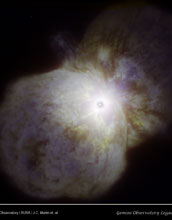Multimedia Gallery
Eta Carinae Star System
The Eta Carinae star system, as imaged by the Gemini South Telescope in Chile, with the Near Infrared Coronagraphic Imager (NICI) using adaptive optics to reduce blurring by turbulence in the Earth's atmosphere. In this image, the bipolar lobes of the Homunculus Nebula are visible with the never-before imaged Little Homunculus Nebula, visible as a faint, blue glow mostly in the lower lobe. The Butterfly Nebula is visible as the yellowish glow with dark filamentary structure close to and mostly below-left of the central star system. The central star system appears as a dark spot due to the coronagraphic blocking (occulting) disk used to eliminate the star's bright glare.
This image is a color composite using three infrared filters: [Fe II] (1.644 micron)--blue layer; H2 2-1 S(1) (2.2465 micron)--green layer; and Br(gamma) (2.1686 micron)--red layer. The field of view for the image is 16.0 x 15.4 arcseconds and is oriented with north up and east to the left.
To learn more about this discovery, see the Gemini news story "Revealing the Explosive Heart of Eta Carinae." (Date of Image: 2009)
Credit: J.C. Martin et. al., Gemini Observatory/AURA
Images and other media in the National Science Foundation Multimedia Gallery are available for use in print and electronic material by NSF employees, members of the media, university staff, teachers and the general public. All media in the gallery are intended for personal, educational and nonprofit/non-commercial use only.
Images credited to the National Science Foundation, a federal agency, are in the public domain. The images were created by employees of the United States Government as part of their official duties or prepared by contractors as "works for hire" for NSF. You may freely use NSF-credited images and, at your discretion, credit NSF with a "Courtesy: National Science Foundation" notation.
Additional information about general usage can be found in Conditions.
Also Available:
Download the high-resolution JPG version of the image. (521 KB)
Use your mouse to right-click (Mac users may need to Ctrl-click) the link above and choose the option that will save the file or target to your computer.



